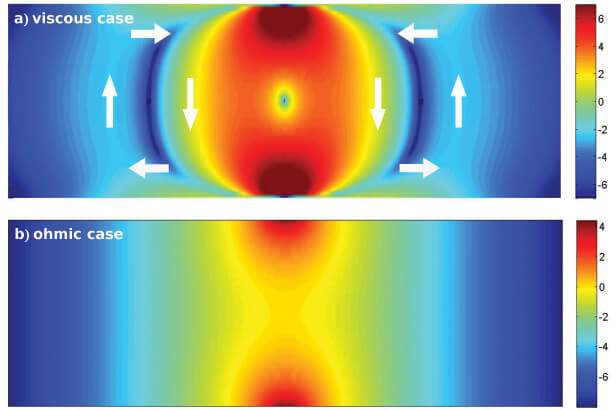Are you a journalist? Please sign up here for our press releases
Subscribe to our monthly newsletter:
Can an electric current behave like a viscous fluid? This somewhat peculiar question has recently been addressed by the Weizmann Institute’s Prof. Gregory Falkovich, together with Prof. Leonid Levitov of the Massachusetts Institute of Technology.
Physics textbooks traditionally describe electricity as a current of electrons. As this current moves through a material – for example, a copper wire – the electrons collide with the atoms in the wire, which creates resistance and slows the current down. But when water or other fluids flow, their molecules bounce off one another. If the current were to behave like a fluid, most of the collisions would occur between the electrons themselves rather than between electrons and other particles. And if such behavior could indeed be proven to exist, it would open an entire new direction for examining and manipulating the properties of electric currents.

Falkovich, an expert on hydrodynamics in Weizmann’s Physics of Complex Systems Department, suggested a classic test case. If electric currents act like fluids, they should, under certain conditions, create vortices, as all fluids do. Vortices are regions in which the flow rotates around an axis so that part of the fluid flows in the opposite direction from which it started. Vortices arise because particles in the fluid interact with one another: When pushed in one direction, these particles transfer some of their momentum to neighboring particles, deflecting their movement sideways and whirling them around. It is thanks to such vortices, for instance, that fish are able to swim: Their undulating movements create sideways vortices that push them forward.
As reported in Nature Physics, Falkovich and Levitov revealed through theoretical analysis that an electric current can indeed form vortices. The researchers performed calculations describing the flow of electrons in the simplest setting possible: across a narrow strip of graphene, a form of carbon just one atom thick. Their calculations showed that when such a current – driven by an electric field from the “minus” to the “plus” electrode, or from high to low voltage – hits the opposite end of the strip, the electrons must turn sideways and then back, and thus they start flowing in the opposite direction, from “plus” to “minus,” as would happen in a fluid vortex.

This conclusion adds an intriguing new chapter to fundamental physics. Textbooks teach students that in accordance with Ohm’s law, electric currents always flow through conducting materials from high voltage to low. It turns out that, strange as this may seem, the current can sometimes flow backward, from low voltage to high.
The revelation suggests ways of analyzing electric currents from an entirely new angle, that of fluid dynamics. And because particles in fluids exert an impact on one another over long distances, such investigations may in the future lead to new means of remotely controlling the electric current in electronic devices.
The findings of this theoretical study have recently received support from an experiment performed in the United Kingdom by the scientists who had won the 2010 Nobel Prize in Physics for their discovery of graphene. In an independent study, reported recently in Science, those scientists built a graphene installation similar to the one proposed by Falkovich and Levitov; they observed a current of electrons that, behaving like a fluid, formed vortices.
Prof. Gregory Falkovich is the incumbent of the Israel Pollak Professorial Chair in Physics.